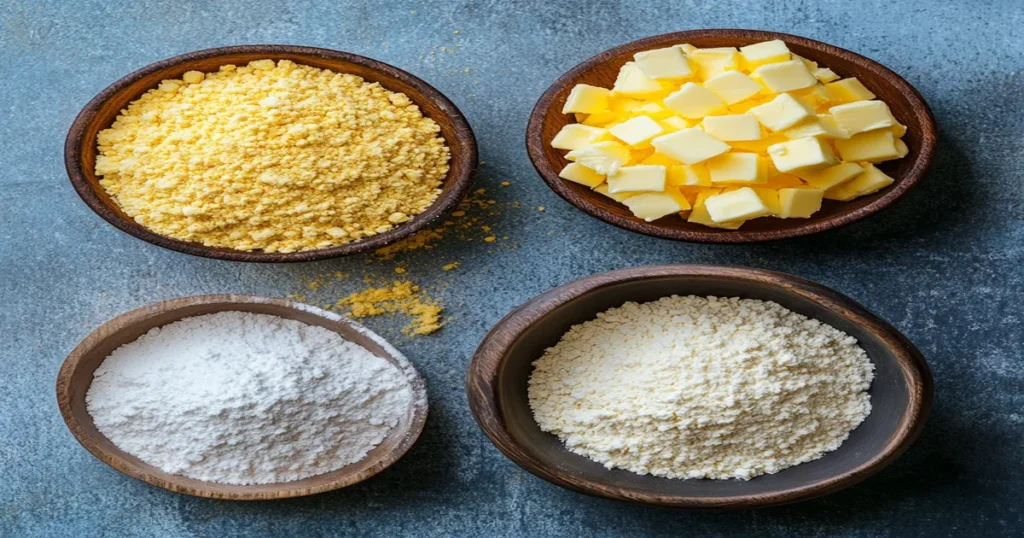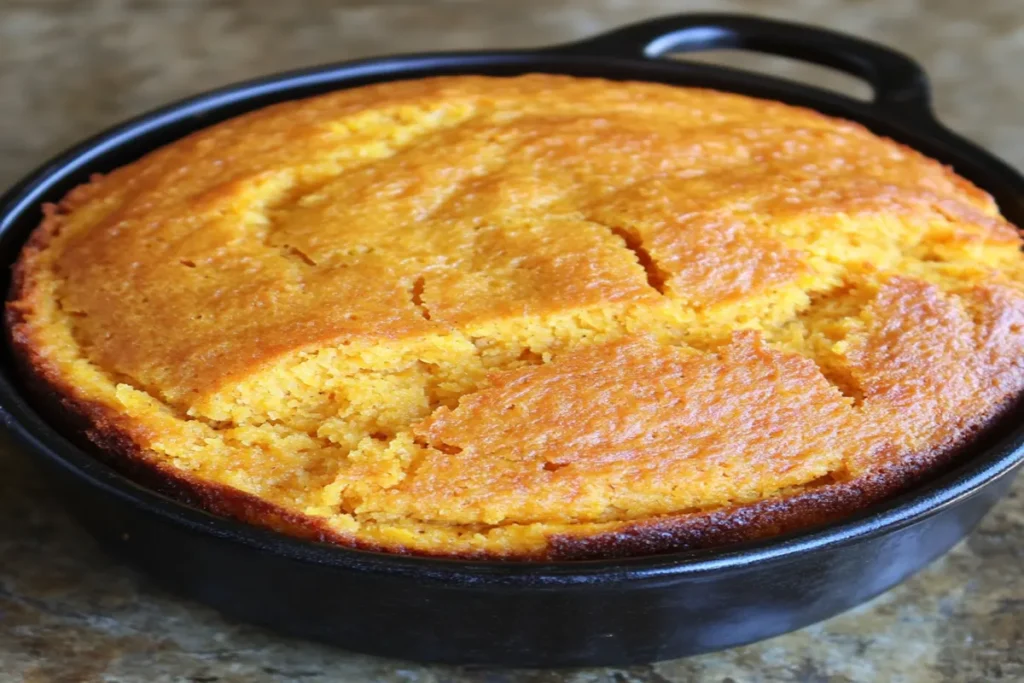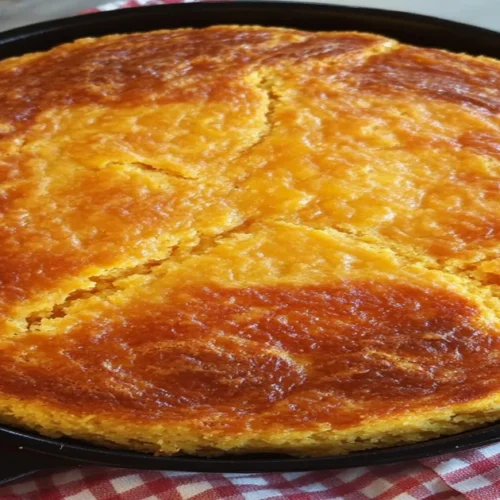Southern cornbread is more than just a side dish; it’s a cherished staple of Southern cuisine, deeply rooted in tradition and family gatherings. Unlike its sweeter counterparts, authentic Southern cornbread boasts a rich, savory flavor and a perfectly crispy, golden crust. Made with simple, wholesome ingredients like cornmeal and buttermilk, it’s a recipe that has been passed down through generations, offering a taste of comfort and nostalgia with every bite.
In this post, we’ll walk you through how to make the best Southern cornbread recipe from scratch. Whether you’re a seasoned cook or trying your hand at Southern cooking for the first time, this easy-to-follow guide will help you create cornbread that’s moist, fluffy, and packed with flavor. So grab your cast iron skillet, and let’s get started!
Ingredients for Southern Cornbread
To make the best Southern cornbread from scratch, the ingredients you choose are just as important as how you prepare them. Each component plays a key role in achieving the perfect texture, flavor, and appearance. Here’s a closer look at the ingredients and why they matter:

Cornmeal is the main ingredient in Southern cornbread
Cornmeal is the star ingredient in Southern cornbread, providing the distinct flavor and grainy texture that sets it apart from other types of bread. For authentic Southern cornbread, opt for medium or coarse-ground cornmeal, as it creates a hearty texture and traditional taste. Avoid cornmeal mixes that already contain flour or leavening agents; these can alter the flavor and consistency of your cornbread. If available, stone-ground cornmeal offers a more robust, earthy flavor that’s closer to what early Southern cooks used.
The role of all-purpose flour in Southern cornbread.
While cornmeal is the main ingredient, a small amount of all-purpose flour helps balance the texture, making the cornbread slightly lighter and less crumbly. The key is to use just enough flour to complement the cornmeal without overpowering its natural flavor.
Please choose either buttermilk, lemon juice, or vinegar based on what you have available.
Buttermilk is essential in Southern cornbread, as it adds a tangy flavor and tender crumb to the bread. Its acidity reacts with the baking powder or baking soda, helping the cornbread rise and creating a fluffy interior. If you don’t have buttermilk, you can make a substitute by mixing one tablespoon of vinegar or lemon juice with one cup of milk and letting it sit for a few minutes. However, real buttermilk is always the best choice for authenticity.
Baking Powder (and Baking Soda, if using buttermilk)
Baking powder serves as the leavening agent, giving your cornbread a light and airy texture. If you’re using buttermilk, a small amount of baking soda is also added to balance its acidity and enhance the rise. Be sure to measure these carefully, as too much can lead to a bitter aftertaste.
One of the things I love is Eggs
Eggs act as a binder, holding the ingredients together and adding moisture to the batter. They also contribute to the structure of the cornbread, preventing it from becoming too crumbly. For the best results, use room-temperature eggs, as they incorporate more easily into the batter.
Butter is the key ingredient that enhances the flavor of southern cornbread.
Melted butter brings richness and a subtle nutty flavor to the cornbread. It also helps create the crispy edges that are a hallmark of Southern cornbread, especially when the batter is poured into a preheated cast iron skillet. Unsalted butter is recommended so you can control the salt level in your recipe.
Make sure to remember the importance of salt.
A small amount of salt enhances the flavors of the other ingredients and prevents the cornbread from tasting bland. Be cautious not to overdo it, especially if you’re serving the cornbread with salty accompaniments like ham or chili.
Step-by-Step Instructions
Before diving into the process of making Southern cornbread, setting up your workspace and properly preheating the oven on the ideal temperature is typically 425°F (220°C) are essential steps to ensure your cornbread bakes evenly and achieves that golden-brown crust, after assembling all the ingredients and tools you’ll need. This includes cornmeal, buttermilk, eggs, butter, flour and any optional add-ins like jalapeños or cheese.

Heat the Cast Iron Skillet (If Using)
If you’re baking your cornbread in a cast iron skillet, place it in the oven while it preheats. Heating the skillet ensures that the batter begins cooking immediately when poured in, creating the crispy edges that Southern cornbread is famous for.
Once the skillet is hot, carefully remove it from the oven using oven mitts, and add a generous amount of butter, bacon grease, or oil. Swirl it around to coat the entire surface evenly. The hot fat not only prevents sticking but also contributes to the rich flavor and crunchy crust.
Prepare the Baking Dish (If Not Using a Skillet)
If you don’t have a cast iron skillet, you can use a baking dish or even a muffin tin. Grease the dish thoroughly with butter or cooking spray to prevent sticking and set it aside. While a baking dish won’t create the same level of crispiness as a cast iron skillet, it will still yield delicious results.
Pouring the Batter and Baking Tips
Once your batter is mixed and your oven is preheated, the next crucial step is transferring the batter to your prepared pan and baking it to perfection. Southern cornbread is all about achieving the right texture and a crispy, golden crust, so attention to detail during this stage is essential. Here’s a detailed guide to pouring the batter and getting the best results:
1. Carefully Handle the Preheated Skillet
If you’re using a cast iron skillet, it will be extremely hot from preheating in the oven. Using oven mitts or a thick towel, carefully remove the skillet from the oven and place it on a heat-resistant surface. The skillet’s heat is key to creating the crispy crust that makes Southern cornbread so iconic.
2. Add Melted Butter or Grease
Before pouring in the batter, add a generous amount of melted butter, bacon grease, or oil to the hot skillet. The fat should sizzle immediately when it touches the hot surface. This sizzling action forms a barrier that prevents sticking and begins crisping the edges of the cornbread as soon as the batter is poured in. Swirl the fat around to coat the bottom and sides of the skillet evenly.
3. Pour the Batter Evenly
Pour the prepared batter into the hot skillet in one smooth motion, being careful not to spill. The batter should spread out evenly across the skillet, and you’ll likely hear a satisfying sizzle as it hits the hot surface. This immediate heat contact helps set the crust. Avoid overfilling the skillet; leave about half an inch of space from the top to allow room for the cornbread to rise.
4. Smooth the Surface (Optional)
For a polished finish, use a spatula or the back of a spoon to gently smooth the surface of the batter. While this step isn’t necessary, it can help ensure even browning and an attractive presentation, especially if you’re serving the cornbread for a special occasion.
5. Bake to Perfection
Place the skillet back in the preheated oven and bake for about 20-25 minutes, or until the cornbread is golden brown and set in the center. The baking time may vary depending on your oven, skillet size, or the thickness of the batter.
To check for doneness, insert a toothpick or knife into the center of the cornbread. If it comes out clean or with just a few crumbs, the cornbread is ready. For extra crispiness, you can broil the cornbread for 1-2 minutes at the end, but watch closely to avoid burning.
6. Cool Slightly Before Serving
Once baked, remove the skillet from the oven and allow the cornbread to cool for 5-10 minutes. This brief resting period helps the cornbread set, making it easier to slice and serve. However, don’t wait too long, as cornbread is best enjoyed warm.
7. Tips for Perfect Results
- Avoid Overmixing the Batter: Overmixing can lead to dense, tough cornbread. Stir the ingredients just until combined; it’s okay if the batter is slightly lumpy.
- Use Room Temperature Ingredients: Room temperature eggs and buttermilk blend more easily into the batter and help the cornbread rise evenly.
- Watch for Hot Spots in the Oven: If your oven has uneven heating, rotate the skillet halfway through baking to ensure even browning.
- Adjust for Personal Preferences: If you prefer a softer, cake-like texture, bake the cornbread for slightly less time. For a crunchier crust, leave it in a few minutes longer or increase the oven temperature slightly during the final minutes.
By following these steps and tips, you’ll achieve perfectly baked Southern cornbread with a moist, fluffy interior and a deliciously crispy crust every time!

southern cornbread recipe
Ingredients
- 1 cup cornmeal yellow or white
- 1 cup all-purpose flour
- 1 tbsp bakink powder
- 1/2 tbsp baking soda
- 1/2 tbsp salt
- 1 cup buttermilk
- 2 eggs
Instructions
Step 1: Preheat the Oven
- Preheat your oven to 425°F (220°C).
- Place a 10-inch cast-iron skillet in the oven to heat up.
Step 2: Mix the Dry Ingredients
- In a large bowl, combine cornmeal, flour, sugar (if using), baking powder, baking soda, and salt.
Step 3: Mix the Wet Ingredients
- In another bowl, whisk together buttermilk, eggs, and melted butter until well blended.
Step 4: Combine Wet and Dry Ingredients
- Gradually add the wet mixture to the dry ingredients. Stir just until combined; do not overmix.
Step 5: Prepare the Skillet
- Carefully remove the hot skillet from the oven. Add bacon drippings or a drizzle of oil to coat the bottom.
- Pour the batter into the skillet, spreading it evenly.
Step 6: Bake the Cornbread
- Bake in the preheated oven for 20–25 minutes, or until the top is golden brown and a toothpick inserted in the center comes out clean.
Step 7: Serve
- Let the cornbread cool for a few minutes before slicing into wedges.
- Serve warm with a dollop of butter or a drizzle of honey. 🍯🧈
Tips for Perfect Southern Cornbread
How to Achieve a Crispy Crust
A crispy crust is one of the defining features of authentic Southern cornbread. It adds a delightful crunch that perfectly contrasts the soft, moist interior. To achieve that golden, crispy crust, there are specific techniques and tips you can follow during the preparation and baking process:
1. Use a Preheated Cast Iron Skillet
The secret to a crispy crust starts with the right cookware, and a cast iron skillet is the gold standard. Cast iron retains and distributes heat evenly, creating the perfect environment for a crisp exterior.
- Preheating is Key: Place your cast iron skillet in the oven while it preheats. The skillet should be piping hot when you pour in the batter, as this immediate contact with heat begins crisping the edges and bottom of the cornbread.
- Alternative Options: If you don’t have a cast iron skillet, you can use a heavy oven-safe skillet or a metal baking dish. However, the results may not be as crispy as with cast iron.
2. Grease the Skillet Generously
Once the skillet is preheated, carefully remove it from the oven and add a generous amount of fat, such as:
- Butter for a rich, nutty flavor.
- Bacon Grease for an authentic smoky taste.
- Oil (like vegetable or canola oil) for a neutral flavor.
The fat should sizzle immediately when it hits the hot skillet, forming a barrier that prevents sticking and enhances the crust’s crispiness. Swirl the fat around to coat the bottom and sides of the skillet evenly.
3. Pour the Batter Into the Hot Skillet
Pour the cornbread batter into the preheated, greased skillet in one smooth motion. The sizzle you hear is the batter beginning to cook instantly, which is crucial for forming the crust. Avoid stirring or spreading the batter too much after pouring, as this can disrupt the crust’s formation.
4. Bake at a High Temperature
A higher oven temperature, typically around 425°F (220°C), helps create a crisp, golden-brown crust while ensuring the interior remains soft and moist. Baking at a lower temperature may result in a softer crust.
5. Broil for Extra Crunch
If you want an even crispier crust, you can place the skillet under the broiler for 1-2 minutes after baking. Keep a close eye on it to prevent burning. This step is optional but can enhance the crunchiness and add a beautiful golden hue to the top of your cornbread.
6. Avoid Using Too Much Flour
The cornmeal-to-flour ratio plays a role in the texture of the crust. Too much flour can make the cornbread softer and reduce the crispiness. Stick to a traditional recipe with minimal or no flour to maximize the cornmeal’s role in creating the desired texture.
7. Don’t Overmix the Batter
Overmixing the batter can lead to a dense, heavy cornbread that doesn’t crisp up well. Stir just until the ingredients are combined, leaving a few lumps in the batter. This light handling ensures the cornbread has the right consistency for a crispy crust.
8. Cool Slightly Before Slicing
Once the cornbread is baked, let it cool in the skillet for 5-10 minutes. This allows the crust to firm up further, making it easier to slice without crumbling or damaging the crispy edges.
9. Reheat Properly
If you have leftovers and want to maintain the crispy crust, reheat the cornbread in the oven or a toaster oven rather than
For a detailed Southern Cornbread recipe, you can visit Feast and Farm’s Southern Cornbread Recipe.
Conclusion
Southern cornbread is more than just a dish—it’s a time-honored tradition that brings people together. With its crispy golden crust, tender crumb, and rich, savory flavor, it’s the perfect accompaniment to any meal, from hearty chili to classic collard greens.
By following this guide, you now have all the tips and techniques to make the best Southern cornbread from scratch. From choosing the right ingredients and mastering the art of a crispy crust to customizing it with your favorite add-ins, this recipe is as versatile as it is delicious.
So, whether you’re honoring a family tradition, exploring Southern cuisine, or simply craving comfort food, this cornbread recipe is sure to deliver. Serve it warm, share it with loved ones, and enjoy the simple yet profound joy of homemade Southern cornbread! discover auther recipe here




